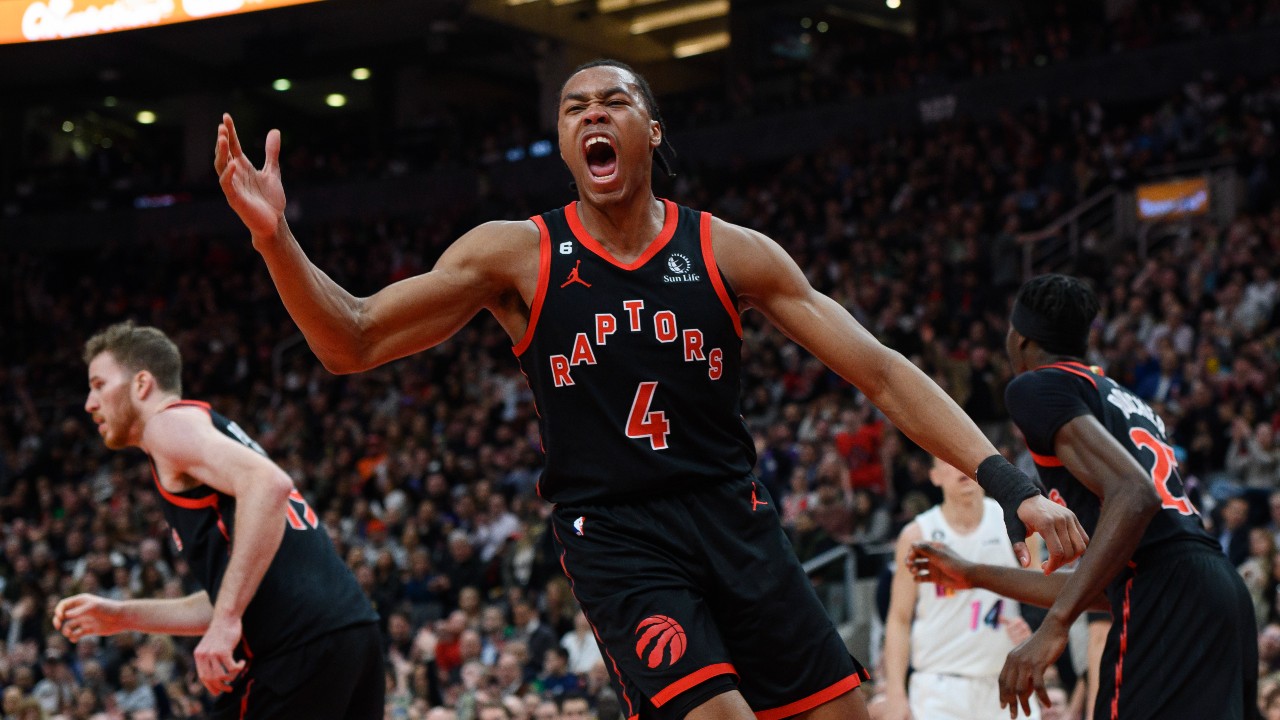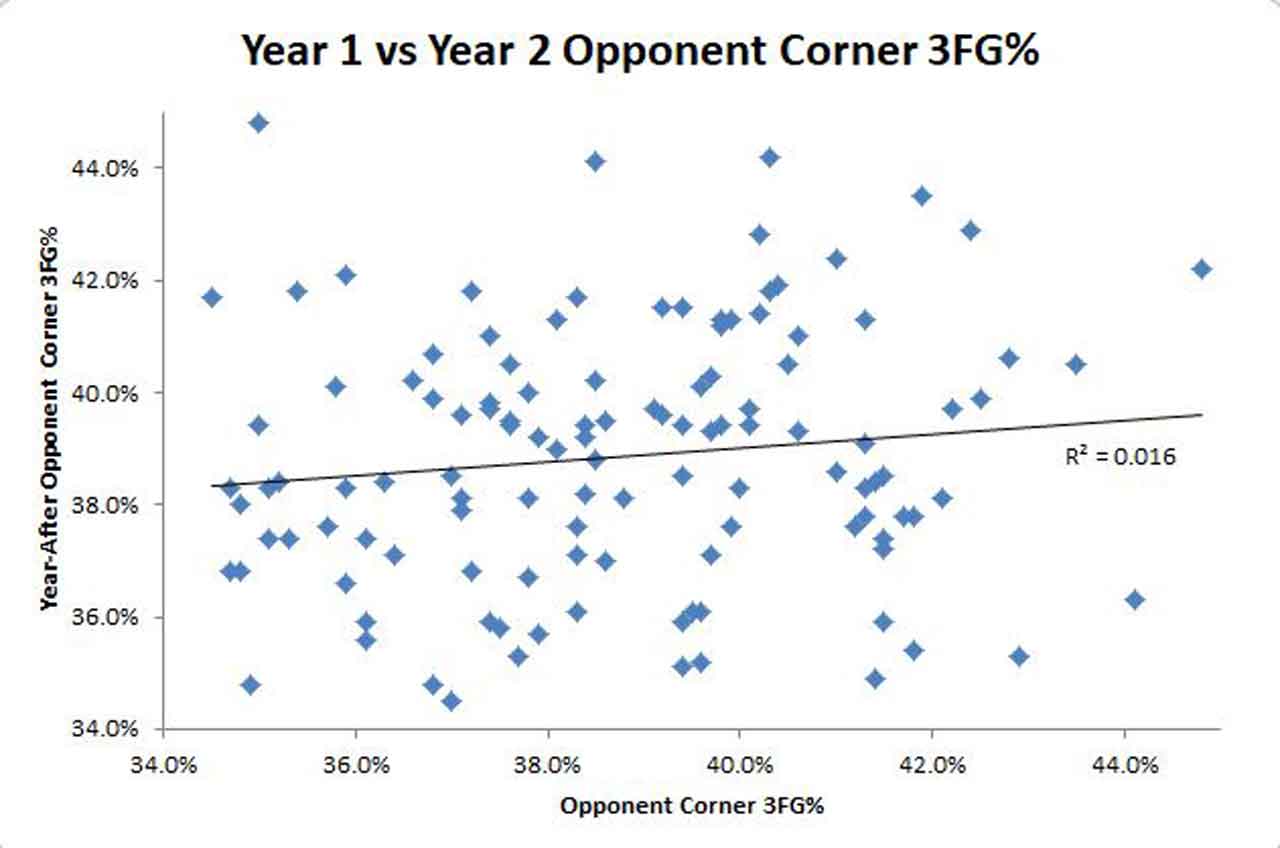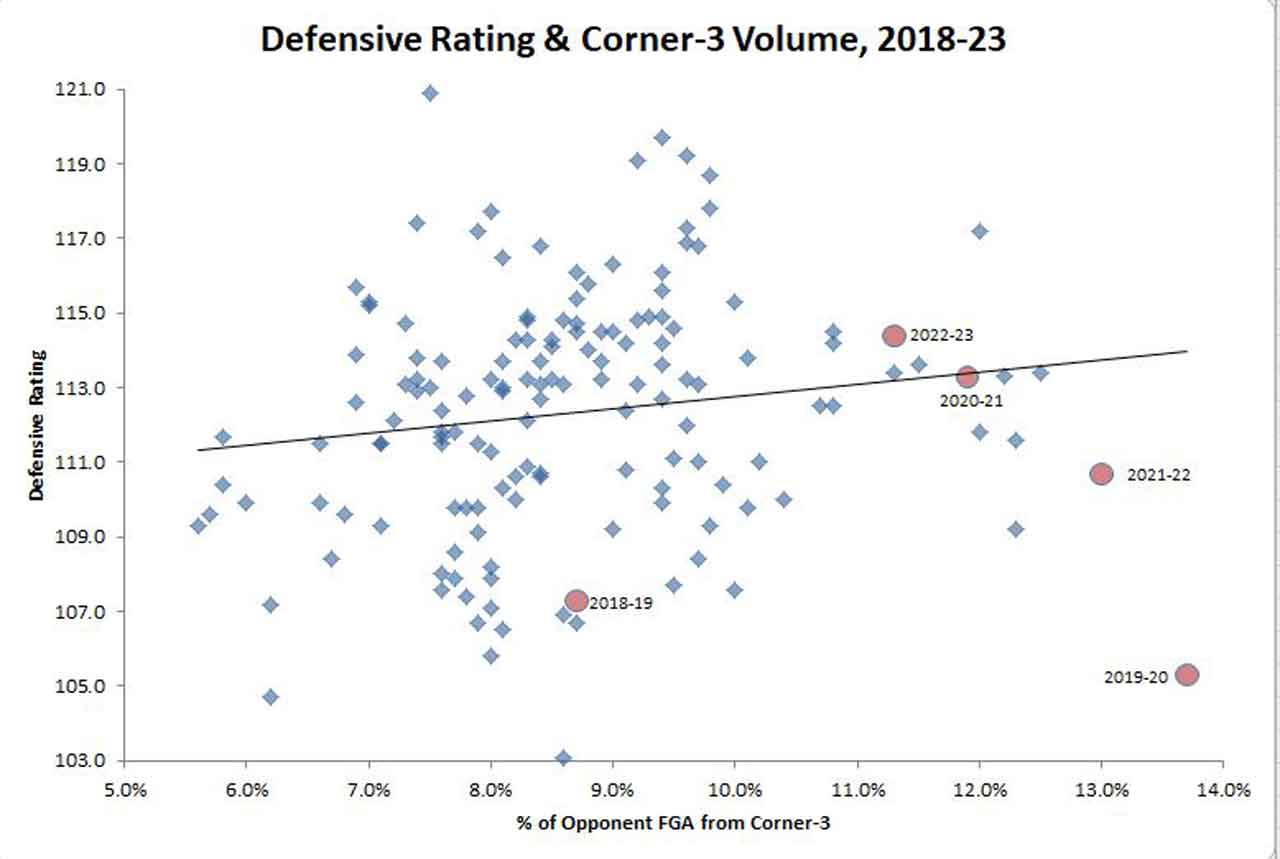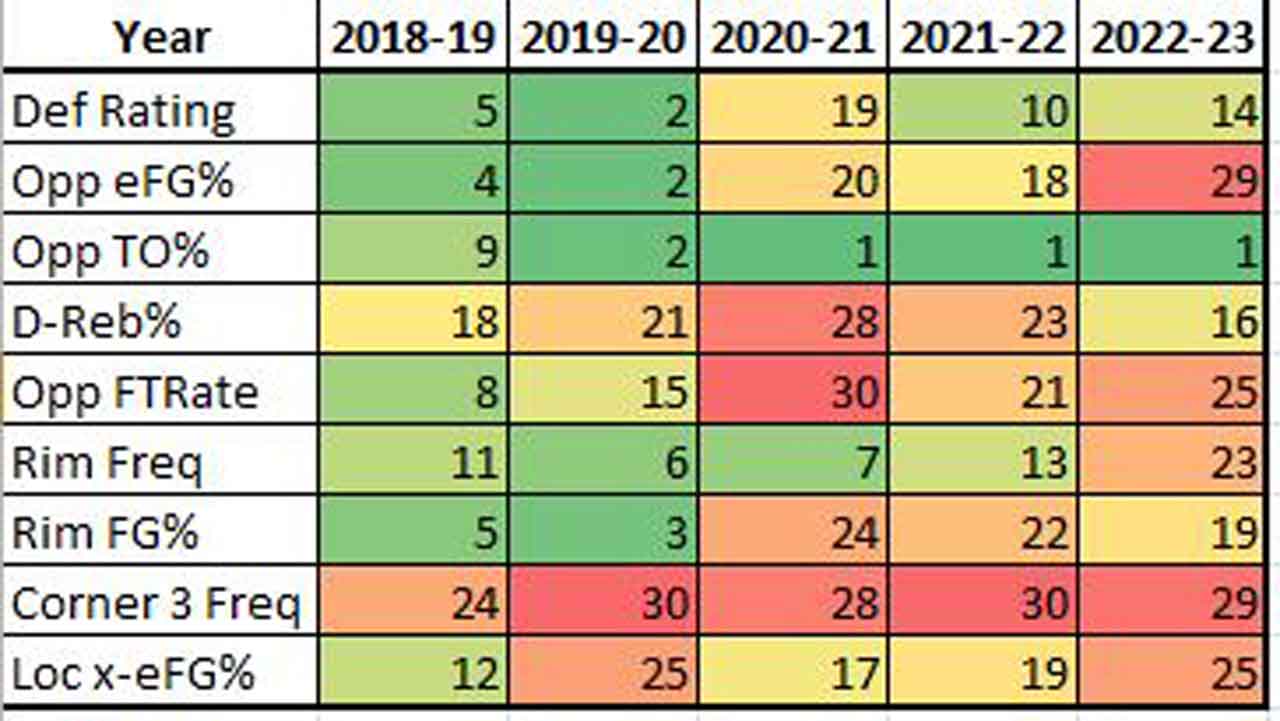
Midway through the 2019-20 season, the run-it-back Toronto Raptors were surprising the NBA by maintaining most of the regular-season success they’d experienced in their NBA Championship season the year prior. When it came to their defence, “surprising” had gone out the window, replaced instead by dumbfounding, flabbergasting, or, at mildest, perplexing.
That Raptors team was doing something no NBA team had ever done before; allowing opponents to take 13.7 per cent of their field-goal attempts from the highly valuable corner 3-point area. That blew away the existing NBA record and still stands as the record today.
In isolation, that’s not too difficult to comprehend. After all, plenty of defences in NBA history have been mad, and maybe this was just Toronto’s own particular brand of ineffectiveness, allowing opponents to funnel their possessions to one of the most efficient spots on the floor.
Except that the Raptors weren’t bad defensively, not even close.
In fact, they were the second-best defence in the league that season behind only the Milwaukee Bucks, and their defensive rating (points allowed per 100 possessions) that season is the third-best mark in the league over the last five years. The Raptors were turning a basic defensive principle on its head, not surviving but thriving defensively while allowing the most corner threes ever, at a time when every offence is trying to create those exact shots.
At the time, I examined a number of possible explanations. Nothing was satisfying. The Raptors allowed those shots to worse shooters and later in the clock than an average corner three, but those differences were very small. The Raptors believed their length and speed closing out on shooters could impact shooters, as evidenced by them lapping the league in blocked threes.
The issue with any such explanation, though, was that the Raptors didn’t hold opponents to a terrible percentage on those shots; opponents hit 37.4 per cent of their corner threes, only the ninth-lowest mark in the league, and we have years of data that suggests teams have much more control over the volume and location of opponent threes than they do over 3-point percentage.
How did the Raptors make it work?
Here is, roughly, the actual explanation for how the Raptors pulled this off: Allowing a lot of corner threes was, of course, not the goal of the defence, it was simply something they were willing to live with as a trade-off for all of the other things they did well. Nick Nurse had his team employ a very aggressive defensive style, one that was designed to make opposing offences uncomfortable, funnel the ball into increasingly tighter spaces, limit the impact of superstar players, and create a ton of turnovers that would help fuel Toronto’s transition offence.
The math around “most corner threes ever” is difficult, but the math around taking way more shots than your opponent (by winning the turnover and rebounding battles) and making sure stars take fewer of those shots is pretty straightforward. The Raptors weren’t an elite defence because they allowed a lot of corner threes. They allowed a lot of corner threes because that was the price of playing their preferred style.
The trade-off was well worth it, as the Raptors ranked second in the league in forced turnovers and second in opponent effective field-goal percentage (field-goal percentage adjusted for the additional value of 3-pointers) while being roughly league-average on the defensive glass and in their foul rate. Most notably, their strategy allowed them to keep opponents away from the only spot on the floor more efficient than the corner: The rim, where the Raptors allowed the sixth-lowest rate of attempts and the third-lowest field-goal percentage.
Watching the strategy unravel after 2019-20
Even understanding the strategic trade-offs, there remained questions about the sustainability of this approach. Would it work without centres as large and defensively savvy as Marc Gasol and Serge Ibaka? Could opponents make an adjustment, knowing how much pressure their ball handlers would be seeing, and from where? Was it just too delicate a balance to sustain, needing to execute expertly everywhere else on the floor? And what would happen in the odd game where an opponent got really hot from the corners?
The Tampa Tank season followed, lowering the fidelity of our data while also laying clear some of the pitfalls of the approach, as opponents hit a ridiculous 41 per cent of their corner threes. The 2021-22 team got back to being a top-10 defence, but further warning signs flashed, as in addition to the volume of corner threes they also struggled to protect the paint.
By the middle of the 2022-23 season, the results no longer supported the strategy, without much room for debate. The Raptors were allowing a lot of corner threes and allowing a parade to the rim and fouling like crazy. Leading the league in forced turnovers was no longer enough – not even close – because when opponents didn’t turn the ball over, they scored at nearly the highest rate in the league. All the turnovers helped the Raptors to a league-average defence and a best-in-class transition offence once again, but “average defence” was not how that team was designed to win or where expectations were for the group.
What went wrong?
The somewhat chaotic strategy made a lot of sense in the post-Kawhi Leonard environment. Gasol, and to a lesser extent Ibaka, was tailor-made to use his size as a paint-deterrent rather than traditional shot-blocker, the team had a number of strong individual defenders with the length and speed to force turnovers, and there was enough continuity for all of those difficult, on-a-string reads and help assignments to work.
That all got tougher as time went on. The centres weren’t replaced with equivalently talented bigs, or by bigs at all. Opponents learned how and where to find soft spots in the trap-heavy approach. An ever-evolving suite of aggressive defensive packages took mental and physical tolls. The combination of personnel, time, and the less tangible factors that inform execution all went in the wrong direction.
In short, it was an incredibly difficult trade-off to pull off effectively, one that highlights how special the 2019-20 defence was, more than anything else. (An aside: This exact type of thinking, experimenting, and game planning is what made Nick Nurse such a great choice for a Philadelphia 76ers team that needs to sharpen their defence around Joel Embiid.)
Changes ahead under Darko Rajakovic
The Raptors signalled as far back as February that they were ready to try a new approach on defence. The addition of Jakob Poeltl was only (mildly) confusing on the asset and timeline side of things; the on-court fit has always been quite straightforward. In Poeltl, the Raptors have their first traditional centre in some time, one who is capable of helping protect the paint without the benefit of an extreme defence in front of him.
Rajakovic has also suggested a change in philosophy, specifically noting that the team would like to cut down on the number of corner threes they allow and do a better job on the defensive glass.
The early pre-season returns show a team that will defend pick-and-rolls a bit more conservatively and use their length differently, as an asset to better defend while staying closer to shooters rather than letting that length help close larger distances. Dialling back the aggression in help defence or trapping scenarios should, in theory, allow players to better understand and execute their assignments on the boards. It can also help to simplify roles and assignments, and while Rajakovic will need to be creative and flexible to get the best out of the defence opponent-to-opponent, this approach is a better theoretical use of their strong individual defensive talent.
O.G. Anunoby is perhaps the best example of this. One of the best and most versatile defenders in the league, Anunoby probably doesn’t need help shading heavily in his direction from possession to possession. He thrived in Nurse’s system, to be clear, this is just a shift that could even better highlight the lock-down aspect of his defence. Similarly, better defining a role for Scottie Barnes could be beneficial as he switched defensive positions more than anyone in the NBA last year – he and Anunoby were truly positionless – and while he’s adept everywhere, his strengths lie closer to the paint than the perimeter at this stage.
Poeltl and Dennis Schroder are less switch-oriented players, generally, but the option remains to be creative and utilize the team’s size and length across the floor. That will be especially true when Poeltl hits the bench, as Precious Achiuwa’s strengths lie in his positional versatility, too. That is all to say that while this Raptors defence will look different, and often a bit more conservative, we shouldn’t expect to see them drift too far from the defensive ideals of Vision 6’9”.
A change in scheme or philosophy is only as valuable as how you execute it. The Raptors were a league-average defence with a lot going wrong last year, thanks to talented personnel and strong game planning. Rajakovic has the opportunity to utilize that personnel differently and more effectively, finding a balance between the overall philosophy and the strengths of the roster. Another challenge will be finding the right level of aggression in passing and driving lanes to create deflections and turnovers, a long-time Raptors strength that is crucial for generating easy offence.
Change was necessary for a number of reasons this off-season, and the focus on a more egalitarian offence will be justified. The defensive tweaks will likely be subtler, as defence is largely defined by what doesn’t happen. A prior approach that was once quite outside the box and almost paradoxically effective needs a course correction, and Rajakovic has the exciting challenge of turning elite length and strong personnel back into a top-10 defensive unit.










